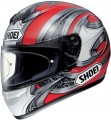SHARP safety rating
The results shown by this helmet model in the SHARP safety rating.
SHARP is a comprehensive testing methodology designed to determine the degree of protection and safety level when using a helmet. Each helmet is tested for direct (linear) impact as well as glide impact friction; in the first case, the acceleration acting on the motorcyclist's brain is measured, in the second, the twisting force acting on the neck is also measured. Tests are conducted for different points of impact, each test involves a minimum of 32 test collisions (more if necessary). The data obtained is compared with information about real injuries, and based on this, the helmet is rated on a five-point scale — from 1 to 5 stars.
The higher the SHARP rating, the safer the helmet and the lower the chance of serious injury while wearing it. However, when choosing this parameter, it is worth considering some nuances. First, the SHARP check is only done on models sold in the UK; and therefore the absence of such certification does not mean poor protection — it may indicate that the helmet simply did not make it to the test. Secondly, the cost of a helmet practically does not affect the number of stars: neither 5 stars for a low-cost model, nor 2-3 stars for a top one are rare. Thirdly, the SHARP programme only checks safety in collisions, it does not affect issues of convenience, aerodynamics, visibility, etc. And even the SHARP experts themselves recommend choosing the most conveni...ent models first, and only then choosing the option with the highest number of stars.
Safety certification
Safety certification or certifications to which the helmet conforms. To date, the following types of certificates are found in motorcycle helmets:
—ECE 22.05. The European certification system, which provides for very strict requirements for safety testing among national and international standards (except that in the ACU the requirements can be even tougher). According to ECE 22.05, each batch of helmets must be tested before being sent for sale (for this, several test items are selected), and the testing itself is quite strict and takes into account the fact that motorcyclists' heads can have different sizes and weights. Helmets certified according to this standard are used even in professional motorsport (although, of course, products of different levels and purposes can pass certification).
—
Snell. Also known as SMF. Standard developed and used in the USA; appeared in the mid-1950s, and has been regularly improved and refined since then. Snell's requirements are more relaxed than ECE 22.05, but tougher than DOT: products must undergo constant quality control, and the test takes into account the possible difference in head size (although it does not take into account the difference in weight).
— DOT. The standard was developed by the US Department of Transportation back in 1972 and has remained virtually unchanged since then. It provides for very mild conditions for b
...oth the testing itself and the control of the results. So, the check is carried out only for the standard size and weight of the head, the manufacturer himself does this and he also determines whether his products comply with DOT requirements, and control by the Ministry of Transport is limited to periodic selective testing. However, even with this in mind, having a DOT is much preferable to no certification at all.
— ACU. A standard developed and maintained by the British Motorcycle Union (Auto-Cycle Union), a public organization representing the interests of the motorcycle community. Provides two main marking options — ACU Gold and ACU Silver; however, the second option is extremely rare for a number of reasons, and it is usually the top, “gold” marking that is used. In order to be ACU Gold certified, a helmet must not only meet certain generally accepted standards (described above by Snell 2005 or ECE 22.05, British BSI Type A, etc.), but also be tested according to ACU rules, which require additional checks. As a result, the ACU Gold marking corresponds to a very high level of safety. Note that some time ago this system was at the centre of a scandal: there were rumors that “ACU Gold” stickers are sold freely and can be found even on low-quality helmets that have not passed (and are not able to pass) an official test. However, the ACU organization has taken steps to correct the situation, and conscientious sellers do not go for such a deception. However, if you have any doubts, you can check from official sources (for example, the ACU website on the Internet) whether the selected helmet meets the safety level claimed for it.
